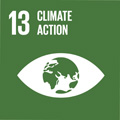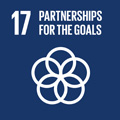- Docente: Paola Galletti
- Credits: 6
- SSD: CHIM/06
- Language: Italian
- Moduli: Paola Galletti (Modulo 1) Alessandro Girolamo Rombolà (Modulo 2)
- Teaching Mode: Traditional lectures (Modulo 1) Traditional lectures (Modulo 2)
- Campus: Ravenna
- Corso: First cycle degree programme (L) in Environmental Sciences (cod. 8011)
-
from Feb 21, 2025 to May 30, 2025
-
from Feb 24, 2025 to May 21, 2025
Learning outcomes
At the end of the course, the student will have a knowledge of the major classes of pollutants to air, water and soil and their sources. The student will know and predict the main degradation pathways and effects of an organic or inorganic substance introduced into the environment. The student will also know the natural cycles of major chemical elements and the main environmental chemical measures. Students will also know about the impact of novel technologies for the sustainable management of waters and energy.
Course contents
3 credits (24 hours) will be dedicated to topics related to organic
compounds of environmental interest.
The topics to be discussed are detailed below: the concept of
persistence and the evaluation of the lifetime of an organic
compound in the environment.
Partition of organic compounds between different environmental
compartments, vapor pressure, solubility in water, air-water and
octanol-water partition coefficients. The
process of absorption and water-solid partition.
Estimation of the mobility of organic matter and mean residence
times in the different compartments.
Nature and role of humic acids in the transport of organic
pollutants.
The chemistry of organic compounds in the atmosphere: photochemical
and radical reactions.
Atmosphere and organic pollutants: mechanisms of depletion of stratospheric ozone, the role
of chlorofluorocarbons; formation of tropospheric ozone and other
secondary pollutants, the role of the organic component in
photochemical smog, tropospheric oxidation of volatile organic
hydrocarbons.
Main classes of organic substances in the atmosphere, sources,
persistence and toxicity.
Aliphatic and aromatic hydrocarbons, polycyclic aromatic
hydrocarbons, particulate absorption.
Chlorinated compounds: polychlorinated dibenzo-1 ,4-dioxins,
polychlorinated dibenzofurans and polychlorinated biphenyls.
The industrial
accident in Seveso.
Greenhouse effect: mechanisms of absorption of infrared
radiation.
Main classes of organic pollutants in water and soil: sources,
persistence and toxicity. Hydrocarbons from oil spills, hydrocarbon
and chlorinated solvents from industrial activities, pesticides,
herbicides, surfactants, halogenated organic substances from
industrial and agricultural activities, organometallic
compounds. Gasoline additives and
oxygenates.
Main mechanisms of degradation of organic compounds in water and
soil: reactions of hydrolysis, photolytic processes, redox
reactions, microbiological degradation.
2 CFU
(16 hours) will be held by Professor Alessandro Rombolà and dedicated to the
following themes of environmental analytical chemistry:
Methods of microextraction of organic pollutants.
Analysis of priority and emerging pollutants using LC-MS, GC-QTOF, tandem MS, Orbitrap techniques.
Analysis of elements by ICP-MS.
The laboratory (1CFU, 12 hours) will provide activities related to
the topics covered in lectures. It will take place in Ravenna in
the laboratories of chemistry within the Environmental Sciences
laboratories "R.Sartori".
Students will work in
small groups and at the end of the lab will produce a brief written
report
Readings/Bibliography
Lecture notes
S. E. Manahan, Chimica dell'ambiente, Piccin
B. Rindone, Introduzione alla Chimica Ambientale, Città Studi Edizioni
R. P. Schwarzenbach, P.M. Gschwend, D. I. Imboden, Environmental Organic Chemistry, Wiley Interscience
R. A. Larson, E. J. Weber, Reaction mechanisms in environmental organic chemistry, Lewis Publishers
Teaching methods
Lessons and discussion.
Practical laboratory training.
As concerns the teaching methods of this course unit, all students must attend Module 1, 2 [https://www.unibo.it/en/services-and-opportunities/health-and-assistance/health-and-safety/online-course-on-health-and-safety-in-study-and-internship-areas] online, while Module 3 on health and safety is to be attended in class. Information about Module 3 attendance schedule is available on the website of your degree programme
Assessment methods
The examination at the end of the course will assess the
achievement of learning objectives:
- Knowledge of the main classes of pollutants in air, water and
soil, and of their sources.
- Understanding and prevision of the major degradation pathways and
effects of an organic or inorganic substance introduced into the
environment
- Knowledge of the natural cycles of the main chemical elements and
main environmental chemical measurements
The final score of the integrated course is defined by an oral
test, on the average of the marks obtained in three specific
questions on topics related to the main objectives of the
course.
Teaching tools
Lecture slides
Students who need compensatory tools for reasons related to disabilities or specific learning disorders (SLD) can directly contact the Service for Students with Disabilities (disabilita@unibo.it [mailto:disabilita@unibo.it] ) and the Service for Students with learning disabilities (dsa@unibo.it [mailto:dsa@unibo.it] ) to agree on the adoption of the most appropriate measures.
Office hours
See the website of Paola Galletti
See the website of Alessandro Girolamo Rombolà
SDGs




This teaching activity contributes to the achievement of the Sustainable Development Goals of the UN 2030 Agenda.
